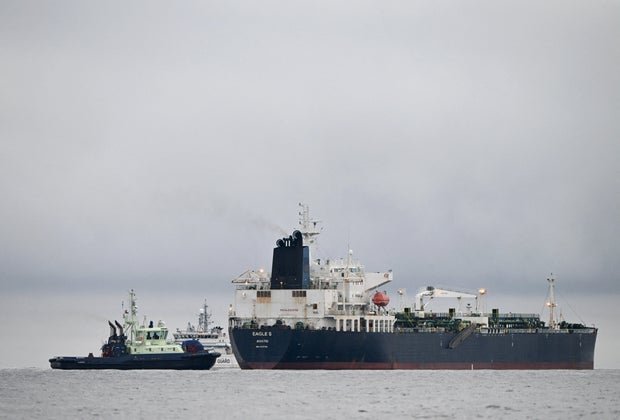Helsinki, Finland — Finnish investigators looking into damage to a power cable in the Baltic Sea and several data cables said they found an anchor drag mark on the seabed, apparently from a vessel linked to Russia, which has already been seized for investigation.
The Estlink-2 power cable, which transmits power from Finland to Estonia across the Baltic Sea, went down on December 25 after an apparent break. This has had little impact on services, but has happened before damage to two data cables and Nord Stream gas pipelinesboth of which were called sabotage.
Finland's chief police investigator, Sami Paila, said late Sunday that the trail stretched for “tens of kilometers … if not nearly a hundred kilometers (62 miles).”
Yussi Nukari/Lehtkuva/REUTERS
“Our current understanding is that the drag mark in question is the anchor of the Eagle S vessel. We were able to clarify this issue through underwater research,” Paila told Finnish national broadcaster Yle.
“I can say that we have a preliminary understanding of what happened in the sea, how the anchor mark was created there,” Paila said, without giving further details. He also emphasized that “the question of intentions is a very important question that needs to be clarified at the preliminary investigation, and it will be clarified during the investigation.”
The vessel was escorted to an inland anchorage in the Porvoo port area on Saturday to facilitate investigations, officials said. Criminal cases have been opened against him for interference in the work of telecommunications, vandalism and offences.
The vessel flies the flag of the Cook Islands, but Finnish customs officials and the European Union's executive commission have identified it as part of Russia's shadow fleet of fuel tankers. They are aging vessels with unclear ownership, bought to circumvent Western sanctions against Russia during the war in Ukraine, and operating without Western-regulated insurance.
Russia's use of the vessels has raised environmental concerns over accidents, given their age and uncertain insurance coverage.
After the cable cut, NATO Secretary General Mark Rutte said last week that the military alliance, which Finland joined last year, would step up patrols in the Baltic Sea region, where tensions have risen since Russia launched a full-scale invasion. of Ukraine in February 2022.
Finland, which shares an 832-mile border with Russia, abandoned its decade-old policy of neutrality and joined NATO in 2023, amid Russia's war against Ukraine.
About seven months after the start of the Russian invasion, a series of underwater explosions ruptured the Nord Stream pipeline, which was built to transport Russian gas to Europe. The reason is not yet confirmed, but Germany has confirmed they were looking for three citizens of Ukraine for questioning on suspicion of sabotage.
At the end of November 2024, parts of two data transmission cables were severed in Swedish territorial waters. Vessel tracking sites show that the Chinese cargo ship Yi Peng 3 was sailing past the cables around the time they were cut.
Russia has responded with derision to early speculation by European officials that the cables may have been damaged by Moscow's war effort. The press secretary of the Kremlin Dmitry Peskov then said that “it is quite absurd to baselessly blame Russia for everything.”

